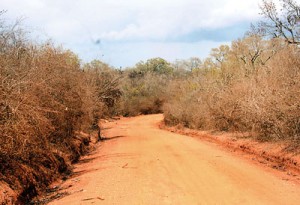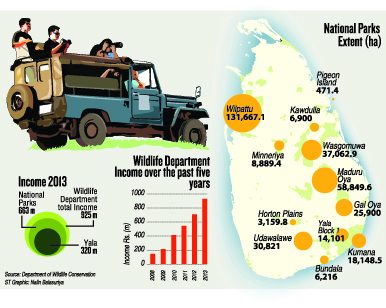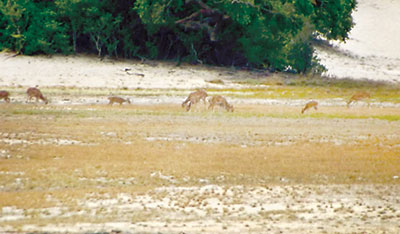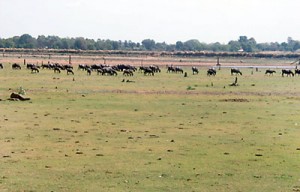News
Worth millions on safari, wild animals are left for dead in Yala
The Yala National Park, one of the most popular tourist attractions in the country, is an almost unrelieved stretch of dried vegetation.
Only the trunk and branches of large trees remain in many places. The bark of most trees is long gone, with animals feeding on it with food now scarce.
The water tanks inside the park have now become large bare areas of dried mud. Along park trails further inside, hoses pumping water from the river to waterholes lie in coils.

The majestic jumbo reduced to skeletons and (left inset) the parched Yala National Park. Pix by Indika Handuwala
The park hosts more than 40 species of mammals, including about 300 elephants, leopards, sloth bears, water buffaloes and deer, as well as numerous bird and reptile species.
It is the largest revenue generator for the Department of Wildlife Conservation (DWC), making close to Rs.320 million last year alone.
But just Rs. 18m has been spent this year on drought relief in the park, and the animals are dying of hunger and thirst.
Our visit to the Yala Park Wildlife Office to meet the park warden was futile: most of the staff were playing cricket nearby while one lone staffer managed the office. We later learned that park wardens in all the national parks were on a strike that Wednesday.
The situation appears to be the same in some other parks (see separate story on this page) which together generated Rs. 663m in 2013, topped by Rs. 680m just by August this year.
With authorities paying little or no attention, the welfare of the wild animals in some of the most popular national parks in the country is under severe threat.
The North Central Province and Eastern Province received little or no rain this year, with rivers and vegetation drying up. Unlike previous years, the north-east monsoon did not arrive as expected, and the wildlife parks, which depend on the monsoon to replenish the water sources, have seen a prolonged drought.
 Witnessing the plight of the animals in Yala, the Head Priest of Situlpawwa Temple, Mataba Hemarathana Thera, launched a feeding programme three weeks ago.
Witnessing the plight of the animals in Yala, the Head Priest of Situlpawwa Temple, Mataba Hemarathana Thera, launched a feeding programme three weeks ago.
A few generous individuals and groups came to his assistance, and he was able to buy 24 barrels of 2000-litre capacity and set up temporary water access points inside the park for the wildlife.
Seeing the animals struggling without food, Hemarathana Thera took trucks of food and distributed it along the trail in Zone 1 for the animals to feed on.
Hearing about his efforts, many people from around the country sent lorry-loads of vegetables to the temple, which the Hemarathana Thera took to the park.
In contrast, the DWC, busy making preparations to celebrate its 65th anniversary, was slow to act.
The Minister of Economic Development Basil Rajapaksa, was quick to acknowledge the importance of national parks to the success of Sri Lankan tourism industry, speaking at the DWC anniversary celebrations on October 1 but despite this overarching acceptance of the value of these assets the Tourism Authority, for its part, has done nothing to assist the DWC in managing the current crisis.

‘Katagama Wewa smells of rotting animal carcasses’ - Mataba Hemarathana Thera
A number of private hotels in the proximity of the parks have, however, been assisting the park management with water distribution during the drought period.
As an immediate reaction to the drought the DWC took measures to fill some waterholes in selected locations – a measure it takes every year during the dry season.
But this is an extraordinary drought, and the department is yet to intervene to address the severe conditions in the parks.
Nor did it support Hemarathana Thera’s efforts, investigations by the Sunday Times revealed.
Park officials claimed that they did not encourage the voluntary relief programme but were not in a position to explain why, in that case, the programme was allowed to go on.
Department officials said if anyone were to bring in food for the animals the provisions should be similar to what the animals feed on inside the park, such as twigs and grass, not vegetables and fruits that humans eat.
“I saw how the animals were struggling without water and I initially put a polythene lining in the dried-up waterholes and poured water inside,” Hemarathana Thera explained. “But that didn’t work as the polythene got torn as animals stepped on it. So I switched to barrels, costing about Rs. 12,000 each.”
A few private donors helped Hemarathana Thera to buy the barrels. After he appealed to MP Namal Rajapaska, the Ministry of Livestock Development sent in an additional bowser which was used for a week; a request has been made for its services for two more weeks.
 Currently, a bowser truck sent by the Hambantota District Secretariat in response to a request from Hemarathana fills the barrels with water every morning.
Currently, a bowser truck sent by the Hambantota District Secretariat in response to a request from Hemarathana fills the barrels with water every morning.
The Thera explained how food started coming in. Following media reports on his efforts private individuals and villages from across the country started sending in food for the animals, he said.
“When the food started coming in, we distributed to different areas of the park and left it for the animals. The animals were starving with no food to eat. There were animals dead inside the park.
“We didn’t want to publicise our efforts as our intention was just to feed the animals. One can’t go around Katagama Wewa – it smells of rotting animal carcasses,” he said.
But the wildlife department was not supportive, he claimed. Some environmentalists had instructed the DWC not to let anyone feed the animals as the natural process should carry on and the animals should learn to adapt to the current conditions.
The park authorities have only carried out the routine work done to deal with the annual drought conditions that occur every September.
With the help of the Hambantota District Secretariat two solar pumps and two diesel pumps have been installed to pump water to some of the waterholes in the Palatupana area from the Lunugamwehera tank.
As well, the water bowser allocated from District Secretariat Office following Hemarathana thera’s request continues to fill waterholes on the Sithulpawwa road boundary every day.
Special measures will only be taken if the drought conditions continue this month as well, the Wildlife Department Director-General, Mr H. D. Ratnayake, told The Sunday Times.
The DWC discourages the feeding of animals as it could be habit-forming and disturb the natural process, said Mr. Ratnayake. Nevertheless, he said the department had not interfered with the feeding programme for fear of criticism.
“As long as it happened at a low level it was okay,” Mr. Ratnayake said.
If the drought conditions continued throughout October the DWC might haveto start its own feeding programme, he added.
Many people have highlighted the need to desilt the tanks inside the parks instead of simply reacting to circumstances during every dry season.
Requests to initiate such a project have been made by individuals willing to fund such a programme, claimed Hemarathana thera but, he said, such initiatives should really come from the government.
Emphasising the need for long-term measures, Colombo University, Zoology Professor D.K. Weerakoon of the University of Colombo said the current situation could be used as an opportunity to gain public support for long-term projects such as the de-silting of tanks in the national parks.
“The DWC functions with a very small budget. It does not have sufficient funds to clear abandoned tanks in the parks. If the tanks are desilted this water problem can be managed,” Prof. Weerakoon said.
The initiative taken by different individuals to feed the wild animals in the park is not an adequate measure considering the extent of the parks in operation in the country, he said.
He does not believe, however, that the feeding would be harmful to the animals. Instead, he thinks that it will help build a better relationship between humans and animals. There would be no negative repercussions if the feeding is managed properly, he added.
“Once the animal realises that there would be no feeding once the rains resume they will go back to their routines. People should be careful not to feed them directly from vehicles or from the roadside,” Prof. Weerakoon said.
No water for animals in our largest national parkText and pix by Hiran Priyankara Jayasinghe  Animals in search of water at dried up water holes Animals of Wilpattu National Park are suffering without proper water sources, with water holes fast drying up due to the prevailing drought. As a result the animals are roaming out of the dense areas of the park in search of water and food and falling prey to poachers. Park officials only distribute water to the few concrete ponds set up by the park management. Warden Manoj Widyaratne said they had to face major issues to provide water to the animals. Nebada vila, Kuruttukandiya vila, Ilandamottai vila, Manikka pola, Iriankulam vila, Kanipura vila are among the water holes that have dried up..
|


